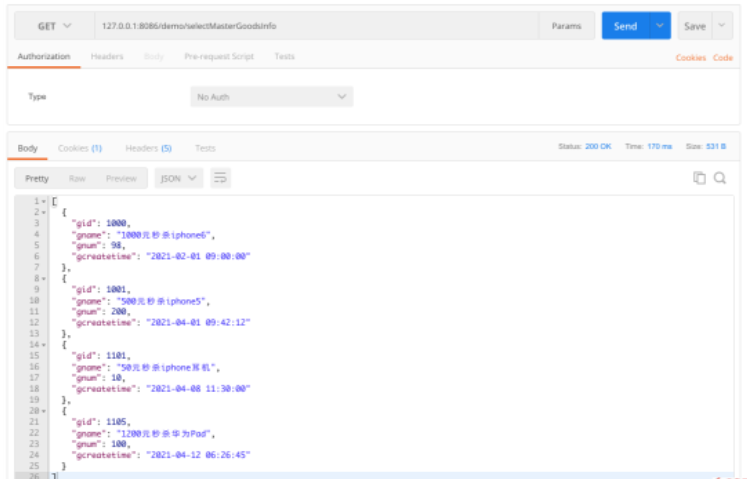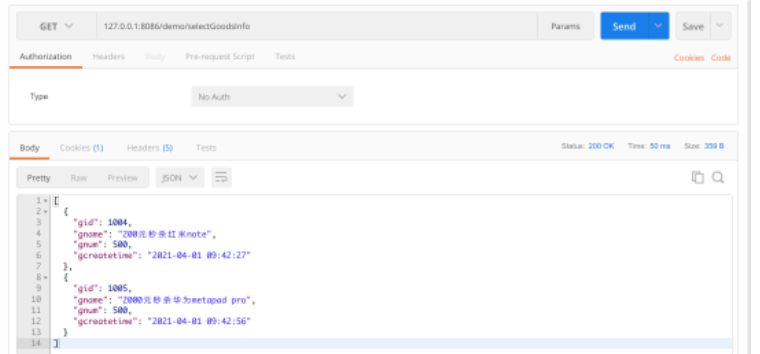 Java
Java
 javaTutorial
javaTutorial
 How to use Dynamic Datasource to configure multiple data sources in SpringBoot
How to use Dynamic Datasource to configure multiple data sources in SpringBoot
How to use Dynamic Datasource to configure multiple data sources in SpringBoot
Functional features:
Supports data source grouping, suitable for a variety of scenarios, pure multi-database, read-write separation, one master, multiple slaves, mixed mode.
Supports startup without data source and supports configuration of lazy startup data source (3.3.2).
Support database sensitive configuration information encryption ENC().
Supports independent initialization of table structure schema and database database for each database.
Supports custom annotations and needs to inherit DS (3.2.0).
Provides fast integration for Druid, Mybatis-Plus, P6sy, Jndi.
Simplify the configuration of Druid and HikariCp and provide global parameter configuration. Configure once and use it globally.
Provide custom data source solutions.
Provides a solution for dynamically adding and removing data sources after the project is started.
Provides a pure read-write separation solution in the Mybatis environment.
Provides a method to parse the data source scheme, using SpEL dynamic parameters. Built-in spel, session, header, support customization.
Supports nested switching of multi-layer data sources. (ServiceA >>> ServiceB >>> ServiceC).
Provides solutions, precautions and examples for integrating third-party libraries such as shiro, sharding-jdbc, quartz, etc.
Provides a distributed transaction solution based on seata. Attachment: Native spring transactions are not supported.
Provides local multi-data source transaction solutions. Attachment: Native spring transactions (3.3.1) are not supported.
Our article mainly implements the separation of reading and writing, and a one-master, multiple-slave environment.
The main database recommends only performing INSERT, UPDATE, and DELETE operations.
It is recommended to only perform SELECT operations from the database.
1. Prepare the database
Main database: PiaoDB



2. Import POM file
Introducing dynamic-datasource-spring-boot-starter.<!-- 多数据源 --> <dependency> <groupId>com.baomidou</groupId> <artifactId>dynamic-datasource-spring-boot-starter</artifactId> <version>3.3.2</version> </dependency>
3. Edit the configuration file
We configured a master library and two slave libraries.Because we are using the Alibaba database connection pool Druid, we need to exclude the native Druid quick configuration class. Other third-party integration address: Druid integration
- The "header" of all data sources separated by underscore _ in the configuration file is the name of the group. Data sources with the same group name will be placed under one group.
- The default data source name is master, which we can modify through spring.datasource.dynamic.primary.
spring: datasource: dynamic: primary: master #设置默认的数据源或者数据源组,默认值即为master strict: false #设置严格模式,默认false不启动. 启动后在未匹配到指定数据源时候会抛出异常,不启动则使用默认数据源. datasource: master: url: jdbc:mysql://localhost:3306/PiaoDB?serverTimezone=Asia/Shanghai username: root password: root driver-class-name: com.mysql.jdbc.Driver # 3.2.0开始支持SPI可省略此配置 slave_1: url: jdbc:mysql://localhost:3306/PiaoDB2?serverTimezone=Asia/Shanghai username: root password: root driver-class-name: com.mysql.jdbc.Driver slave_2: url: jdbc:mysql://localhost:3306/PiaoDB3?serverTimezone=Asia/Shanghai username: root password: root driver-class-name: com.mysql.jdbc.DriverCopy after login
@SpringBootApplication(exclude = DruidDataSourceAutoConfigure.class)
public class Application {
public static void main(String[] args) {
SpringApplication.run(Application.class, args);
}
}spring: autoconfigure: exclude: com.alibaba.druid.spring.boot.autoconfigure.DruidDataSourceAutoConfigure
# 多主多从 纯粹多库(记得设置primary) 混合配置 spring: spring: spring: datasource: datasource: datasource: dynamic: dynamic: dynamic: datasource: datasource: datasource: master_1: mysql: master: master_2: oracle: slave_1: slave_1: sqlserver: slave_2: slave_2: postgresql: oracle_1: slave_3: h3: oracle_2:
4. Write code
Use @DS to switch data sources. @DS can be annotated on methods and classes. If both exist, method annotations take precedence over class annotations. It is strongly recommended to annotate the service implementation or mapper interface method.##1. Write Controller
- @DS("xxx") specifies the data source xxx, where xxx can be a group name or the name of a specific library. If it is a group name, the load balancing algorithm is used when switching. If the specified group name or library does not exist, the default data source (main library) will be automatically used
- If there is no @DS, the default data source (main library) will be used
- If @DS is set but a group or library is not specified, a slave library is selected based on the DynamicDataSourceStrategy strategy. Default load balancing policy.
@RestController
@RequiredArgsConstructor
@RequestMapping("/demo")
public class DemoController {
private final DemoService demoService;
@GetMapping("/add")
public String add() {
return demoService.add(null) + "";
}
@GetMapping("/selectGoodsInfo")
public List<GoodsInfo> selectGoodsInfo(){
return demoService.selectGoodsInfo();
}
@GetMapping("/selectMasterGoodsInfo")
public List<GoodsInfo> selectMasterGoodsInfo(){
return demoService.selectMasterGoodsInfo();
}
}2. Write Service
public interface DemoService {
boolean add(GoodsInfo param);
List<GoodsInfo> selectGoodsInfo();
List<GoodsInfo> selectMasterGoodsInfo();
}@Service
@RequiredArgsConstructor
public class DemoServiceImpl implements DemoService {
private final DemoMapper demoMapper;
@DS("master")
@Override
public boolean add(GoodsInfo param) {
param = new GoodsInfo();
param.setGname("1200元秒杀华为Pad");
param.setGnum(100);
return demoMapper.insertGoodsInfo(param);
}
@DS("slave")
@Override
public List<GoodsInfo> selectGoodsInfo() {
return demoMapper.selectGoodsInfo();
}
@DS("master")
@Override
public List<GoodsInfo> selectMasterGoodsInfo() {
return demoMapper.selectGoodsInfo();
}
}3. Write Mapper
@Mapper
public interface DemoMapper {
boolean insertGoodsInfo(GoodsInfo param);
List<GoodsInfo> selectGoodsInfo();
}<?xml version="1.0" encoding="UTF-8" ?>
<!DOCTYPE mapper PUBLIC "-//mybatis.org//DTD Mapper 3.0//EN" "http://mybatis.org/dtd/mybatis-3-mapper.dtd" >
<mapper namespace="com.example.demo.mapper.DemoMapper">
<select id="selectGoodsInfo" resultType="com.example.demo.entity.GoodsInfo">
select * from t_goods_info
</select>
<insert id="insertGoodsInfo">
insert into t_goods_info (gname, gnum, gcreatetime)
values (#{gname}, #{gnum}, now());
</insert>
</mapper>1. Request to add a new interface (add data to the main database): 127.0.0.1:8086/demo/add
2. Request to query the main database data Interface: 127.0.0.1:8086/demo/selectMasterGoodsInfo
 3. Request slave data interface (load balancing):
3. Request slave data interface (load balancing):
First request:
 Second request:
Second request:
The above is the detailed content of How to use Dynamic Datasource to configure multiple data sources in SpringBoot. For more information, please follow other related articles on the PHP Chinese website!

Hot AI Tools

Undresser.AI Undress
AI-powered app for creating realistic nude photos

AI Clothes Remover
Online AI tool for removing clothes from photos.

Undress AI Tool
Undress images for free

Clothoff.io
AI clothes remover

Video Face Swap
Swap faces in any video effortlessly with our completely free AI face swap tool!

Hot Article

Hot Tools

Notepad++7.3.1
Easy-to-use and free code editor

SublimeText3 Chinese version
Chinese version, very easy to use

Zend Studio 13.0.1
Powerful PHP integrated development environment

Dreamweaver CS6
Visual web development tools

SublimeText3 Mac version
God-level code editing software (SublimeText3)

Hot Topics
 1393
1393
 52
52
 37
37
 110
110
 How Springboot integrates Jasypt to implement configuration file encryption
Jun 01, 2023 am 08:55 AM
How Springboot integrates Jasypt to implement configuration file encryption
Jun 01, 2023 am 08:55 AM
Introduction to Jasypt Jasypt is a java library that allows a developer to add basic encryption functionality to his/her project with minimal effort and does not require a deep understanding of how encryption works. High security for one-way and two-way encryption. , standards-based encryption technology. Encrypt passwords, text, numbers, binaries... Suitable for integration into Spring-based applications, open API, for use with any JCE provider... Add the following dependency: com.github.ulisesbocchiojasypt-spring-boot-starter2. 1.1Jasypt benefits protect our system security. Even if the code is leaked, the data source can be guaranteed.
 How SpringBoot integrates Redisson to implement delay queue
May 30, 2023 pm 02:40 PM
How SpringBoot integrates Redisson to implement delay queue
May 30, 2023 pm 02:40 PM
Usage scenario 1. The order was placed successfully but the payment was not made within 30 minutes. The payment timed out and the order was automatically canceled. 2. The order was signed and no evaluation was conducted for 7 days after signing. If the order times out and is not evaluated, the system defaults to a positive rating. 3. The order is placed successfully. If the merchant does not receive the order for 5 minutes, the order is cancelled. 4. The delivery times out, and push SMS reminder... For scenarios with long delays and low real-time performance, we can Use task scheduling to perform regular polling processing. For example: xxl-job Today we will pick
 How to use Redis to implement distributed locks in SpringBoot
Jun 03, 2023 am 08:16 AM
How to use Redis to implement distributed locks in SpringBoot
Jun 03, 2023 am 08:16 AM
1. Redis implements distributed lock principle and why distributed locks are needed. Before talking about distributed locks, it is necessary to explain why distributed locks are needed. The opposite of distributed locks is stand-alone locks. When we write multi-threaded programs, we avoid data problems caused by operating a shared variable at the same time. We usually use a lock to mutually exclude the shared variables to ensure the correctness of the shared variables. Its scope of use is in the same process. If there are multiple processes that need to operate a shared resource at the same time, how can they be mutually exclusive? Today's business applications are usually microservice architecture, which also means that one application will deploy multiple processes. If multiple processes need to modify the same row of records in MySQL, in order to avoid dirty data caused by out-of-order operations, distribution needs to be introduced at this time. The style is locked. Want to achieve points
 How to solve the problem that springboot cannot access the file after reading it into a jar package
Jun 03, 2023 pm 04:38 PM
How to solve the problem that springboot cannot access the file after reading it into a jar package
Jun 03, 2023 pm 04:38 PM
Springboot reads the file, but cannot access the latest development after packaging it into a jar package. There is a situation where springboot cannot read the file after packaging it into a jar package. The reason is that after packaging, the virtual path of the file is invalid and can only be accessed through the stream. Read. The file is under resources publicvoidtest(){Listnames=newArrayList();InputStreamReaderread=null;try{ClassPathResourceresource=newClassPathResource("name.txt");Input
 How to implement Springboot+Mybatis-plus without using SQL statements to add multiple tables
Jun 02, 2023 am 11:07 AM
How to implement Springboot+Mybatis-plus without using SQL statements to add multiple tables
Jun 02, 2023 am 11:07 AM
When Springboot+Mybatis-plus does not use SQL statements to perform multi-table adding operations, the problems I encountered are decomposed by simulating thinking in the test environment: Create a BrandDTO object with parameters to simulate passing parameters to the background. We all know that it is extremely difficult to perform multi-table operations in Mybatis-plus. If you do not use tools such as Mybatis-plus-join, you can only configure the corresponding Mapper.xml file and configure The smelly and long ResultMap, and then write the corresponding sql statement. Although this method seems cumbersome, it is highly flexible and allows us to
 Comparison and difference analysis between SpringBoot and SpringMVC
Dec 29, 2023 am 11:02 AM
Comparison and difference analysis between SpringBoot and SpringMVC
Dec 29, 2023 am 11:02 AM
SpringBoot and SpringMVC are both commonly used frameworks in Java development, but there are some obvious differences between them. This article will explore the features and uses of these two frameworks and compare their differences. First, let's learn about SpringBoot. SpringBoot was developed by the Pivotal team to simplify the creation and deployment of applications based on the Spring framework. It provides a fast, lightweight way to build stand-alone, executable
 How SpringBoot customizes Redis to implement cache serialization
Jun 03, 2023 am 11:32 AM
How SpringBoot customizes Redis to implement cache serialization
Jun 03, 2023 am 11:32 AM
1. Customize RedisTemplate1.1, RedisAPI default serialization mechanism. The API-based Redis cache implementation uses the RedisTemplate template for data caching operations. Here, open the RedisTemplate class and view the source code information of the class. publicclassRedisTemplateextendsRedisAccessorimplementsRedisOperations, BeanClassLoaderAware{//Declare key, Various serialization methods of value, the initial value is empty @NullableprivateRedisSe
 How to get the value in application.yml in springboot
Jun 03, 2023 pm 06:43 PM
How to get the value in application.yml in springboot
Jun 03, 2023 pm 06:43 PM
In projects, some configuration information is often needed. This information may have different configurations in the test environment and the production environment, and may need to be modified later based on actual business conditions. We cannot hard-code these configurations in the code. It is best to write them in the configuration file. For example, you can write this information in the application.yml file. So, how to get or use this address in the code? There are 2 methods. Method 1: We can get the value corresponding to the key in the configuration file (application.yml) through the ${key} annotated with @Value. This method is suitable for situations where there are relatively few microservices. Method 2: In actual projects, When business is complicated, logic



